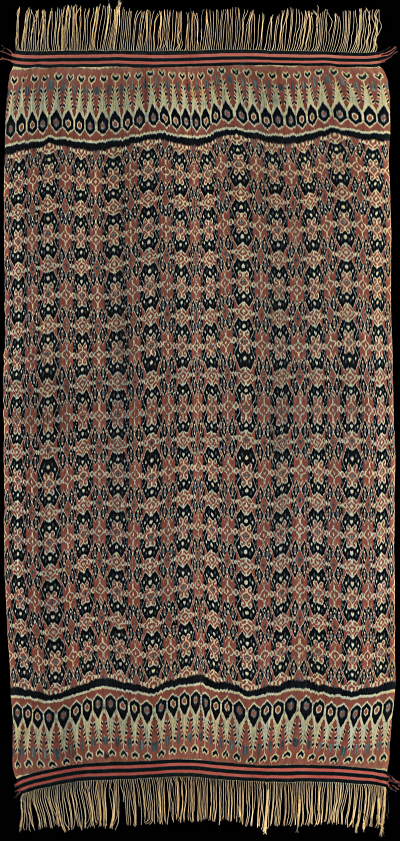| |
 
 | | | |
193 Sumba, East Sumba
Hinggi (men's blanket)  
| | Locale: | Kapunduk | | Period: | Early 20th C. | | Yarn: | Cotton, hand-spun, fine, double-ply | | Technique: | Warp ikat | | Panels: | 2 | | Size: | 117 x 257 cm (3' 10" x 8' 5") LW: 2.20 | | Weight: | 815 g (28.7 oz), 271 g/m2 (0.89 oz/ft2) | | Design: | Field covered in patola ratu motif, inspired by double ikat silk tradecloths, patola, bordered by band of aquatic animals at either end, probably representing the large and fearsome Bobbit sea worm (an Eunice species). The patola ratu motif, reserved for the maramba, the highest class, by 1924 (Adams) was still seen as belonging to the court of Kapunduk, and spoken of as patola ratu Kapunduk. It was later imitated in other districts. | | Comment: | Intricate design with patola ratu pattern covering the entire field, sea-worm borders. The patolu ratu pattern at the time of weaving was the preserve of Kapundak royalty. The piece represents the highest level of Sumban weaving, its powerful presence formed by the combination of technical perfection and stylistic restraint. Ex collection Rita and René Wassing-Visser, and before them F. Blok, 'Boeatan'. Two tiny holes with carefully done old repairs, almost invisible. A true pusaka, in near perfect condition. | | Background: | Chapters on Sumba and East Sumba. | | Exhibited: | Hong Kong University Museum and Art Gallery, 2017. | | Published: | Ikat Textiles of the Indonesian Archipelago, 2018.
Ikat from Timor and its Outer Islands, 2022.
Noble Virtuosity: Hidden Asymmetry in Ikat from Sumba, 2024. | | Compare: | 194 061 062 234 | | Sources: | Akin to late 19th - early 20th C. hinggi in Adams, Forshee et al., Decorative Arts of Sumba, Page 118-119. Also similar to hinggi from same period on Page 126-127, which has the same sea worm borders at the extremities, but a less ably executed, more sketchy centre field. Similar to early 20th C. hinggi from Collection Lüth in Khan Majlis, Woven Messages, except that in our example the whole field (except the bands with sea worms at the extremities), is covered in patola ratu motifs. Similar to hinggi in Metropolitan Museum, 1988.104.58, though our example has more intricate patterning. Similar to slightly narrower but equally intricate hinggi in National Gallery of Australia, NGA 2000.990. Sea-worm motif on hinggi acquired in 1921 shown in Adams, System and Meaning in East Sumba Textile Design, Fig. 54. Information on property of patola ratu motif in Adams, System and Meaning in East Sumba Textile Design, p. 145. A similar, though less detailed pre-1954 hinggi is in the Volkenkunde collection, RV-3120-1, as well as a simpler pre-1939 version, RV-2429-18. | | |

©Peter ten Hoopen, 2024
All rights reserved.
|
|


